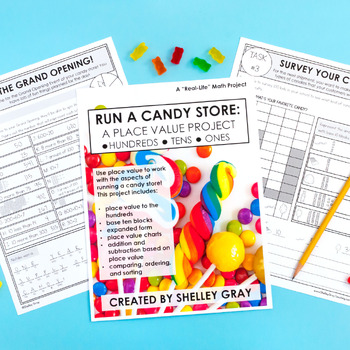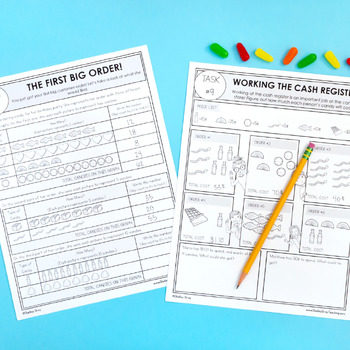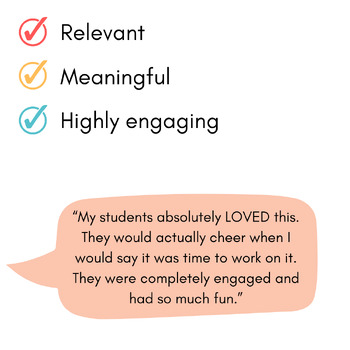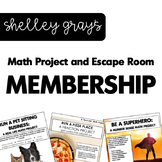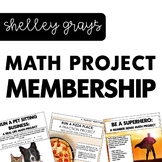Place Value Math Project for 2nd and 3rd Grade - Run a Candy Store
- PDF
- Google Apps™

What educators are saying
Also included in
- Ready to infuse real-life experience into your Math class? Math projects are a great way to do just that!This is a bundle of TEN Math Projects and Escape Rooms: Run a Candy Store (place value to 100)The Camping Trip (addition and subtraction to 100)Run a Pizza Place (fractions)Back In Time (to the OPrice $39.75Original Price $48.25Save $8.50
- Would you like to have access to ALL of the Math Projects and Escape Rooms that I create?I will be continuing to add projects to this growing bundle as I post them. All curriculum will continue to be 2nd-5th grade focused. Owning this membership access ensures that you have the material to challengePrice $179.00Original Price $244.45Save $65.45
- Would you like to have access to ALL of the Math Projects that I create?This membership currently includes 37 math projects, spanning from 2nd grade to 5th grade curriculum (some can be used for 6th). As I create more projects, they will be added to this bundle.Purchasing this membership bundle ensuPrice $105.00Original Price $178.00Save $73.00
Description
Are you looking for a way to reinforce place value concepts in an engaging way that helps your students make connections? “Run a Candy Store” is a real-life math project where students will complete eleven different place value tasks.
You might choose to print specific tasks to use during Math centers, or you might make a booklet out of all of the tasks and let your students choose which one to do when. The choice is yours.
Take a look at what you’ll find inside this math project:
TASK #1: THE PLAN
You can’t believe it! Your family is buying a candy store and YOU get to help run it! Let’s think of a name for the candy store and design a poster to advertise.
TASK#2: STOCKING THE SHELVES
Your first shipment has come in and it’s your job to stock the shelves with candy! Figure out how many of each candy was ordered.
Skills: place value chart, comparing and ordering
TASK#3: SURVEY YOUR CUSTOMERS
You decide to survey 100 kids in your school to see what kind of candy is their favorite. Interpret the graph and represent the candy with base 10 blocks.
Skills: skip-counting, base 10 blocks, graphing and data interpretation, addition, subtraction
TASK #4: THE GRAND OPENING
It’s time for the Grand Opening Event at your candy store! You have lots of fun things planned for the day. First up, spin the wheel to see what each person wins! Next, guess the number of candies in the jar!
Skills: base 10 blocks, expanded form, comparing and ordering, addition, subtraction, number words
TASK #5: THE MYSTERY GUEST
You are SO excited about the mystery guest who is handing out candy at the Grand Opening! Use the place value clues to shade the picture and discover who the mystery guest is!
Skills: tens and ones
TASK#6: THE FIRST BIG ORDER
You just got your first big customer order! Let’s take a look at the graphs to see what she would like!
Skills: skip-counting, picture graphs, data interpretation, addition
TASK#7: INVENTORY DAY
Inventory is important when you own a business! This means that we count all of the candies to see what we have available.
Skills: number words, expanded form, comparing and ordering, adding multiples of 10 and 100
TASK #8: SURPRISE BAGS
You decide to make up some surprise bags to sell! Inside each surprise bag will be a variety of candy.
Skills: skip-counting, addition
TASK #9: WORKING THE CASH REGISTER
Working at the cash register is an important job at the candy store! Figure out how much each person’s candy will cost.
Skills: skip-counting, addition, money
TASK#10: CANDY SPILL!
Oh no! The gumball machine fell over and ALL of the gumballs fell. Out! As you clean up the gumball mess, you count each color of gumball.
Skills: skip-counting, number words, addition
TASK#11: GUMMY SALES
Gummy bears and gummy fish have been the most popular candies at the store so far. Interpret the tally charts to show how many packages have sold this week.
Skills: addition, tens and ones
*
*
WAYS TO USE MATH PROJECTS IN YOUR CLASSROOM:
Math projects are an ideal way to consolidate learning. I recommend using them as an engaging activity AFTER skills have been learned rather than during learning. You will likely find that engagement is very high and that your students ask to do more of these!
There are many ways to use math projects in your classroom. Some of the most popular are:
•a small-group or pairs activity
•a guided math activity to allow you to see where your students are struggling
•a fun, rewarding way to engage your early finishers
•a low-prep, easy-to-implement activity for a substitute teacher
•
Enjoy!
Shelley Gray

